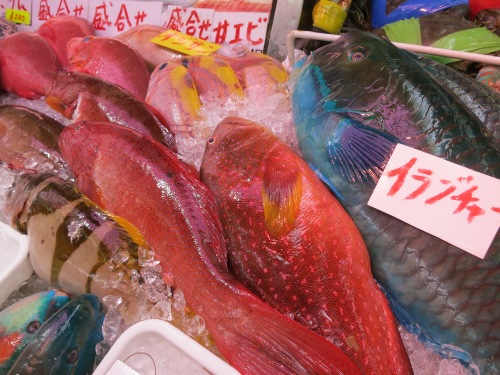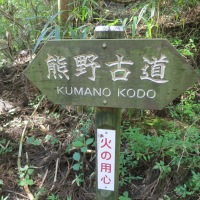Tokyo may be famous for its fresh sushi bars and seemingly uncountable ramen joints; the old capital of Kyoto offers diners a peek into the high art of Kaiseki cuisine as well as a variety of tea sweets; a trek into sacred Koya-san will lead one to the heart of the vegetarian Shojin-ryori fare of the Buddhist monks and Shinto priests; and a neon-filled night out on the town in Osaka will inevitably include a bevy of fried foods and octopus balls to sate its drunken revelers; yet if you venture farther South to the islands of Okinawa, you’ll find yourself dining on an entirely different set of standards.
The tropical climate of the Southern Islands has given way to an entirely different set of fruits and vegetables than what is seen up North, increased trade with other nations such as China, the Philippines, and Korea during the Ryukyu period has allowed for a further inclusion of outside culinary influences, the entirely island-bound lifestyle automatically means an abundance of fresh creatures from the sea, and the presence of Western Nations during the last World War added the final seasoning with the introduction of such noble ingredients as spam and cheap tacos (NOTE – sarcasm intended) – all factors which have worked to shape the culinary landscape and define what is now known as Okinawan Cuisine.
As is usual with my food-specific posts, I first must lay out the disclaimer that what follows isn’t a comprehensive list of all that makes the food of Okinawa unique; it is merely a sampling of what is out there to be discovered, the primary points of order, or the most famous dishes available. And, as I’m sure you guessed, before any culinary tour can begin, we first must start with the base ingredients – translation: we’re off to the market (specifically the Makishi Public Market in Naha, in this case):

The Makishi Public Market is a great place to get a handle of the types of meat, seafood, produce, and dry goods that are most readily available

A friendly vendors offering up samples of his salted, pickled, fermented, and just generally preserved foods

Don’t worry, I didn’t eat any more “Still-living” fish while in Okinawa – the one time in Kyoto was enough for me

Okinawa boasts its own unique varieties of tofu, as well, which manage to find their way into many of the islands’ stir-fried dishes

A series of bustling restaurants occupy the second floor of the market, all taking advantage of the proximity to the market below. In fact, you can even purchase your seafood or ingredients down below, carry it upstairs, and then have one of the restaurants cook them up to order

Personally, I wasn’t quite confident in my seafood selection procedures, thus, I left it up to the professionals an opted for their best sashimi platter
Getting to the heart of the matter, the actual cuisine itself is largely composed of everyday dishes available to the common family, as opposed to being characterized by the haute fare only available to the noble families as in other parts of the world. Additionally, the Okinawans stick to an extremely healthy fare – almost medicinal, including plenty of seaweed, protein-rich and lean pork, plenty of vegetables, and other foods high in acid — believing that what you eat defines how you live. They should know, too, considering the fact that Okinawans have the longest life expectancy of any other ethnic group on the planet, into which cuisine certainly plays a significant part. Here is a brief run-down of a few of the major dishes I was able to sample:

The classic Okinawan Stir-fry: Goya Champaru, which utilizes the ever-present Bitter Melon (Goya), a form of tofu unique to the islands, and a touch of pork thrown in for good measure

Okinawan Soba, which is centered around a pork-bone-based Tonkatsu broth, to which the island’s unique soba noodles are added along with pork spare ribs (and occasionally fish cakes, as seen here)

It doesn’t have to be complex to be good – the perfect example being that of the island favorite “Taco Rice.” Essentially taco ingredients (seasoned beef, lettuce, cheese, and tomatoes) served atop rice as opposed to in corn tortilla shells. This holdover from the American occupation can be found in almost any restaurant on the islands, but is best eaten while enjoying a beautiful beach view, as seen above

Umi-budo, or “Sea grapes” are usually served raw with a ponzu dipping sauce (although they do occasionally find their way into a few sushi preparations, too)

Rafute — a dish of generously sliced Pork Belly (think bacon, just un-smoked and cut in a different manner) that has been slow-simmered in a sauce of ginger, brown sugar, sweet rice wine, and soy sauce. Meltingly good…

Squid Ink is another common ingredient. Seen here is a bowl of Ikasuji Jyusi, which is bits of squid, squid ink, and rice cooked in an almost risotto-like manner

A stew utilizing Na-bera, a less-common vegetable otherwise known as “Spongy Gourd,” or so I’m told. And those little pink bits floating around in there? Oh yeah, those are hunks of span – I told you they actually eat that stuff here!
When it comes to drinking alongside your meal, the Okinawans know how to party. Along with the island’s macro-brewed Orion beer, the drink of choice is that of Awamori. Although it is often referred to as Okinawan Sake, this undercuts that fact that Sake (Japanese rice wine, also known as nihonshu) usually only contains about 14-16% alcohol, whereas Awamori pushes the limits and clocks in at anywhere between 30-60% alcohol – meaning it is far closer to a liquor than that of a wine. So before you go ahead an order an entire bottle, be forewarned: you’re going to regret it the next day!

A traditional pottery serving vessel for Awamori (incidentally, Okinawa is also famous for its pottery). Due to its lethal alcohol content, Awamori is usually served with a bucket of ice and a glass of water for dilution, as seen above

It is harder to find, but there are also a few brands of jizake, or local sake, available on the island, too

Even though the flavor is nothing particular to write home about, it is still hard to beat a frosty glass of Orion beer after sweating it out all day in the island’s tropical heat and humidity
In addition to the main courses seen above, another tangent of dishes has developed that either compliment well, or are meant to be paired with, the variety of different alcohols available. So basically, these next few dishes are bar snacks (but good bar snacks) that are meant to fill the stomach whilst on an Awamori bender:

Hirayachi – a crepe-like creation (or pizza, if you will) using an eggy-pancake batter that is then topped with mayo, nori strips, and benito flakes (occasionally, you’ll also see a Taco version of Hirayachi, as well, further pushing the taco-fusion-envelope)

As mentioned above, Okinawans have their own unique variety of tofu. Additionally, they also create their own version of fermented tofu, or “Tofuyo,” which – if it wasn’t already pungent enough – they then douse in a sticky, spicy sauce to up the flavor quotient. Obviously, I’ve eaten my fair share of Stinky Tofu in my travels through Taiwan and China, but I have to say, that stuff is nothing compared to the funk that is Tofuyo. Eat with caution.

Pickled spring onions, offering a palette-cleansing, garlicky punch-in-the-face to go with that glass of pure booze
Finally, there are also a few sweat treats to check out for either a quick mid-afternoon snack or to satisfy that post-meal sweet-tooth:

Sata Andagi – dense, chewy, deep-fried doughnuts that are often infused with flavors such as mango or banana

I never caught the name of these cookies (despite the fact that seemingly every store sells them), but they consist of a small, boat-like cookie that is topped with a purple sweet potato filling and lightly charred on top under a broiler

Buka Buka Cha – an indigenous tea that is topped with a mountain of foam created by whipping up rice flour and water into a frothy mess. It can be a bit cumbersome to drink, but it does taste good!

And lastly, I couldn’t validly say I visited Okinawa without trying its famous “Blue Seal” Brand ice cream. This American-borne ice cream maker has uniquely adopted island ingredients for its flavors: seen here is a scoop of Shiiquasa (a local citrus fruit) on top of a scoop of Beni-imo, a type of purple sweet potato. Tasty!
I’ve still got another few days of exploring Okinawa ahead of me — specifically the islands of Ishigaki-jima and Iriomote-jima, much farther to the South – although I am admittedly about a week behind on my posts (technically I’ve already arrived in a new country, but for the sake of the blog, we’ll pretend that everything is up to date). So until then, best of luck with that Awamori hangover!

 August 16, 2013
August 16, 2013 













As usual Andrew, this is not one to read when hungry! Okinawan food looks so different from what you’d expect in the bigger islands – I can definitely make out the Chinese influence from the pork belly and gyoza. All of them look delicious (except maybe not the tofuyo!), personally I’d love to try the “sea grapes” and squid ink rice, not to mention the sweet potato cookies and pickled/tempura spring onions. Spam has always been a guilty pleasure of mine, I adore it pan-fried and served with rice and mayo. 😛
Thanks for sharing all these photos, you’ve now convinced me to put Okinawa further up the wishlist! Wonder if you got the chance to snorkel the world’s northernmost coral reefs…
Unfortunately, this trip didn’t include any snorkeling, however, I do hear that there are some fantastic dive spots throughout the islands. I was too busy eating and laying by the beach to partake this trip, however! 🙂
Wow….the views while dining. …….
Honestly, with that view, they could have set a plate of dirt down in front of me and I would have happily eaten it. For some reason, everything seems to taste better within sight of a beach!
Andrew, I’m the weakest when I see a picture of a sashimi platter. I just love sashimi, whatever the fish is. So you can imagine how much time I spent looking at that picture of sashimi of yours. 🙂
Anyway, I see at least two vegetables widely consumed by the Okinawans which I happen to love: bitter melon and spongy gourd. My mom usually cooks bitter melon with shrimps and carrot to bring up more sweetness to the dish, while for the spongy gourd she usually mixes it with spinach to make a clear soup of green veggies. So at least I know I’m eating well. 🙂
You better make sure you’ve got your pension in order, as eating all that spongy gourd and bitter melon means you’ll be living long like the Okinawans! Ha ha. And I couldn’t agree with you more in regards to the sashimi. Not only is it a favorite dish of mine as well, but I love the fact that almost every seafood restaurant (which really means almost any restaurant) in Japan will automatically have a sashimi platter. You can’t go wrong!
I’m looking forward to reading this when I have some time. My dad lived in Okinawa before he married my mom. I’ve always been super curious about Japan, and Okinawa in particular.
I CAN’T BELIEVE YOU’RE STILL TRAVELING! Did you find anywhere you’d like to put down roots?
Jenn
It’s funny that you should mention that I’m still traveling, as I’m on my farewell tour at the moment. And although I’ve passed through a number of amazing countries and cities in which I’d love to live, I’m actually preparing to head back home and lay down some roots back in Ohio (Columbus, specifically). Whereas I’ll always have a fondness in my heart for some of the destinations that I’ve visited, there is something valuable to having friends and family close by. Thanks for following along all these months, and I hope everything is well in your world, Jenn!
I was three years in Oki, ’57 thru ’60 thanks to the US Air Force. Thanks for this site. Having spent a lot of time in the Vill, I consumed a lot of Oki food. Made me homesick even after all these years.